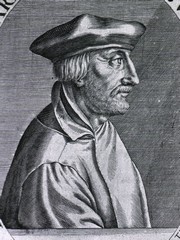This article is part of the series "A Moment in History" where we honor those who have contributed to the growth of medical knowledge in the areas of anatomy, medicine, surgery, and medical research.

Insert text here
Jacobus Sylvius (1478 - 1555). French physician, teacher, and anatomist, Sylvius was born in poverty as Jacques Dubois, in the city of Louisville, near Amiens. He would eventually become known as Jacobus Sylvius Ambianus. In spite of his humble beginnings Sylvius entered the College of Tournay. Too poor to continue his studies he started to instruct in anatomy, which helped him earn enough to obtain a bachelor’s degree in Medicine in 1531 in Montpellier.
Sylvius returned to Paris as a demonstrator in anatomy, where he excelled. He had many famous students, among them was Andrea Vesalius. Sylvius followed strictly the teachings of Galen, a situation that eventually caused not only his downfall, but enmity with Vesalius and others. Sylvius was also of the opinion that the student of anatomy should learn from dissection as well as from the books. One of Sylvius’ most important achievement was that he added to the Galenic numerical description by numbers, a descriptive nomenclature creating many names in used today such as brachialis, tibial, peroneus, scalene, serratus, biceps, triceps, etc. He is also responsible for many other names such as femoral, popliteal, subclavian, phrenic, axillary, spermatic, epiploic, etc.
Sylvius was a controversial man. He was known for being greedy, a miser, and the use of foul language, but at the same time he wrote a book to guide the poor student who wanted to get through Medical School. He was finally appointed professor of Medicine at the Royal College of Paris, a position he held until his death in 1555.
Sylvius was so enraged with Vesalius’ denouncement of Galen as being wrong, that he started a personal war against him including sending letters to the King and through public letters where he called Vesalius a madman (vaesanus), plus “purveyor of filth and sewage, pimp, liar, and various epithets unprintable even in our own permissive era” (excerpt from Magner, 1992)
Although many attribute the eponyms of the lateral cerebral sulcus (Sylvian fissure) and the cerebral aqueduct (aqueduct of Sylvius) to Jacobus Sylvius, these two structures are actually named after Franciscus Sylvius (1614 – 1672) a German anatomist. On top of this, some of the structures actually discovered by Jacobus Sylvius were named eponymically after someone else, like the incomplete valve found at the junction of the inferior vena cava and the right atrium, named after Bartholomew Eustachius (c.1520 - 1574).
Sylvius’ contribution to anatomy is immeasurable, but his personality traits have made him lose status and almost forgotten.
Sources:
1. “Advice for Poor Medical Students: Sylvius, J. Translated by O’Malley CD J Hist Med 1962 17:141-151
2. “A Historical Lesson from Franciscus Sylvius and Jacobus Sylvius” Bakkum DC (2011) J Chir Hum 18:94-98
3. “A Historical Mistake: The aqueduct of Sylvius” Leite Dos Santos, AR et al Neurosurg Rev (2004) 27: 224-225
4. “Jacobus Sylvius (Jacques Dubois) 1478-1555 – Preceptor of Vesalius” JAMA (1966) 195 13; 1147
5. "Andreas Vesalius; The Making, the Madman, and the Myth" Joffe, Stephen N. Persona Publishing 2009
6. “A History of Medicine” Magner, LN Ed. M Deckker Pub 199
Original image courtesy of Images from the History of Medicine



